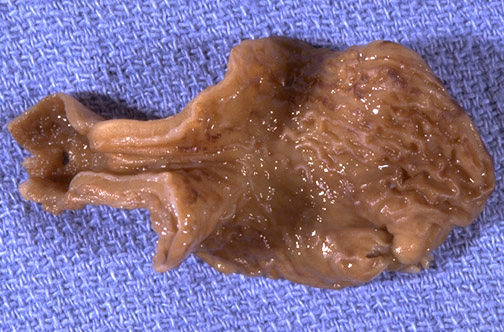Pyloric stenosis pathophysiology: Difference between revisions
No edit summary |
|||
| Line 4: | Line 4: | ||
==Overview== | ==Overview== | ||
The [[pathogenesis]] of infantile hypertrophic pyloric stenosis is not completely understood. However, infantile hypertrophic pyloric stenosis may result from abnormal innervation of the pyloric [[smooth muscle]].The [[chloride]] loss due persistent vomiting results in [[hypochloremia]] which impairs the [[kidney]]'s ability to excrete [[bicarbonate]]. This is the significant factor that prevents correction of the [[alkalosis]]. | The [[pathogenesis]] of infantile hypertrophic pyloric stenosis is not completely understood. However, infantile hypertrophic pyloric stenosis may result from abnormal innervation of the pyloric [[smooth muscle]].The [[chloride]] loss due persistent vomiting results in [[hypochloremia]] which impairs the [[kidney]]'s ability to excrete [[bicarbonate]]. This is the significant factor that prevents correction of the [[alkalosis]]. The secondary [[hyperaldosteronism]] develops due to the [[hypovolaemia]].The body's compensatory response to the [[metabolic alkalosis]] is [[hypoventilation]] resulting in an elevated arterial p[[Carbon dioxide|CO<sub>2</sub>]]. | ||
== Pathophysiology == | == Pathophysiology == | ||
Revision as of 14:53, 8 December 2017
|
Pyloric stenosis Microchapters |
|
Diagnosis |
|---|
|
Treatment |
|
Case Studies |
|
Pyloric stenosis pathophysiology On the Web |
|
American Roentgen Ray Society Images of Pyloric stenosis pathophysiology |
|
Risk calculators and risk factors for Pyloric stenosis pathophysiology |
Editor-In-Chief: C. Michael Gibson, M.S., M.D. [1] Associate Editor(s)-in-Chief: Mohamadmostafa Jahansouz M.D.[2]
Overview
The pathogenesis of infantile hypertrophic pyloric stenosis is not completely understood. However, infantile hypertrophic pyloric stenosis may result from abnormal innervation of the pyloric smooth muscle.The chloride loss due persistent vomiting results in hypochloremia which impairs the kidney's ability to excrete bicarbonate. This is the significant factor that prevents correction of the alkalosis. The secondary hyperaldosteronism develops due to the hypovolaemia.The body's compensatory response to the metabolic alkalosis is hypoventilation resulting in an elevated arterial pCO2.
Pathophysiology
The pathogenesis of infantile hypertrophic pyloric stenosis is not completely understood.
- However, infantile hypertrophic pyloric stenosis (IHPS) may result from abnormal innervation of the pyloric smooth muscle.
- Evidence of increased collagen production and abnormal amounts of extracellular matrix proteins has also been seen in patients with hypertrophic pyloric muscle.[1]
- The gastric outlet obstruction due to the hypertrophic pylorus impairs emptying of gastric contents into the duodenum. As a consequence, all ingested food and gastric secretions can only exit via vomiting, which can be of a projectile nature. The vomited material does not contain bile because the pyloric obstruction prevents entry of duodenal contents (containing bile) into the stomach. This results in loss of gastric acid (hydrochloric acid). The chloride loss results in hypochloremia which impairs the kidney's ability to excrete bicarbonate. This is the significant factor that prevents correction of the alkalosis.[2] A secondary hyperaldosteronism develops due to the hypovolaemia. The high aldosterone levels causes the kidneys to:
- Avidly retain Na+ (to correct the intravascular volume depletion)
- Excrete increased amounts of K+ into the urine (resulting in hypokalaemia). The body's compensatory response to the metabolic alkalosis is hypoventilation resulting in an elevated arterial pCO2.
- The pathophysiology for adult-onset hypertrophic pyloric stenosis is not comprehensively understood.
Genetics
In relatives of probands of infantile hypertrophic pyloric stenosis patients and monozygotic cotwins the recurrence pattern did not depict a single major inheritance.[3]
Associated Conditions of Infantile Hypertrophic Pyloric Stenosis
Various conditions associated with infantile pyloric stenosis include:[4]
- Neuromuscular disorders
- Connective tissue disorders
- Metabolic disorders
- Intracellular signalling pathway disturbances
- Intercellular communication disturbances
- Ciliopathies
- DNA-repair abnormalities
- Transcription regulation disorders
- MAPK-pathway abnormalities
- Lymphatic abnormalities
- Environmental factors
Gross Pathology
These are two characteristic findings on gross pathology of pyloric stenosis:


Microscopic Pathology
The following observations may be seen in pyloric stenosis:[6]
- Smooth muscle cells are in a proliferative phase and there is very few gap junctions between smooth muscle cells in pyloric stenosis.
- The circular muscle layer is characterized by very few large granular vesicle-containing nerve fibers.
- The number of nerve cell bodies in the myenteric plexus, and the total number of ganglia is lower than normal.
- Interstitial cells of Cajal are almost completely absent.
References
- ↑ Ohshiro K, Puri P (1998). "Pathogenesis of infantile hypertrophic pyloric stenosis: recent progress". Pediatr Surg Int. 13 (4): 243–52. doi:10.1007/s003830050308. PMID 9553181.
- ↑
- ↑ Mitchell LE, Risch N (1993). "The genetics of infantile hypertrophic pyloric stenosis. A reanalysis". Am J Dis Child. 147 (11): 1203–11. PMID 8237916.
- ↑ Peeters B, Benninga MA, Hennekam RC (2012). "Infantile hypertrophic pyloric stenosis--genetics and syndromes". Nat Rev Gastroenterol Hepatol. 9 (11): 646–60. doi:10.1038/nrgastro.2012.133. PMID 22777173.
- ↑ 5.0 5.1 "Pathology Outlines - Congenital pyloric stenosis".
- ↑ Langer JC, Berezin I, Daniel EE (1995). "Hypertrophic pyloric stenosis: ultrastructural abnormalities of enteric nerves and the interstitial cells of Cajal". J Pediatr Surg. 30 (11): 1535–43. PMID 8583319.